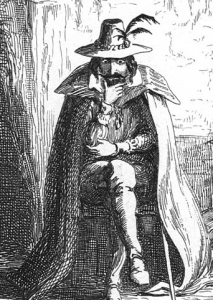CONTENT WARNING
This series discusses sexual violence
and other forms of abuse.
Please read with caution.
Go here for Part One.
The story of St. Maria Goretti is a fairly familiar one to many Catholics. For anyone who doesn’t know or could use a refresher, here’s the skinny.

Born in Italy in 1890, her father’s early death forced the impoverished Gorettis to lodge with and work for another family, the Serenellis. The Serenellis’ son, Alessandro, who was 20 years old, began to sexually harass Maria, who was 11. Eventually, he cornered her alone one day and threatened her with an awl; she refused and resisted, shouting at him that it was a mortal sin. He stabbed her several times before fleeing. Maria was taken to the hospital, but her wounds were too severe for the doctors to treat adequately, and—after declaring that she forgave Alessandro for what he had done—she died.
Alessandro was quickly caught, and spent the next twenty-seven years in prison. During this time, Maria came to him in a dream, in which she gave him lilies which burned his hands; he repented of his crime, accepting his sentence. After his release, he begged forgiveness from Maria’s mother, and eventually became a lay brother for a friary of Capuchins, where he served as their gardener.
Like many other victims of abuse, I admire St. Maria’s strength and compassion. (St. Charles Lwanga hits some of the same beats in a slightly different way.) Unfortunately, how her story gets used is another question.
A Martyr for Purity?
St. Maria Goretti is often held up as a martyr for purity, which may seem intuitive to most readers: she was resisting Serenelli’s sexual advances, what else do you call it? But she was not resisting her own desires here; this was not about the long “apprenticeship in self-mastery” that the virtue of chastity consists in. She was resisting a rapist.
The distinction is important, because when this is framed as an issue of purity, it sends a lot of messages that get poisonous rapidly. It smuggles in the idea—probably unconscious and unintentional for most people—that “she wanted it,” even if she displayed self-control.
It seems to hint, in its emphasis on her virginity, that if Maria had been less than chaste she would have had less right to refuse.
It encourages the tendency to think of rape as sexual desire that’s simply gotten out of hand (“boys will be boys”), rather than being primarily an act of violence, which it is.
It can prop up the idea, in its handling of Serenelli’s later life, that it is women’s job to manage and fix male sexuality.
It suggests that being dead is better than being a rape victim, which carries with it the horrible possibility of a return to the twisted notion that victims, like Lucretia, “regain their honor” through suicide.
And perhaps worst of all, it implies that girls who have been raped have sinned by “letting” it happen.

Like I said, a lot of these ideas are unconscious for a lot of people. And I don’t think everyone who publicly admires Maria Goretti is therefore a bad person, even if they’ve repeated a bad take—we all tend to repeat things that sound good without thinking through all their implications. If anything, religious people are especially prone to do so. But these distortions still lurk in the background, as long as that framing persists.
St. Maria wasn’t holy because of anything that did or didn’t happen to her body. She was holy because she could take pity even on the man who murdered her.1
The Distortions
The same diseased ways of thinking are visible in the handling of the abuse crisis. Countless people, not only priests and bishops but lay commentators, have been treating it for decades as basically a problem of lust. That’s not what’s going on here. Lust leads to fornication, sure, and some clerical misconduct is mere fornication, but lust by itself it does not produce abuse. It requires a different and far graver distortion in the soul to pass from self-indulgently pursuing pleasure to violence against your neighbor.
And when the disease is different, it needs a different cure. Learning greater self-control does not, of itself, make a person any more respectful of others’ dignity or concerned with their welfare. Indeed, a malicious person who has attained self-mastery is a lot more difficult to correct, or even to protect yourself and others against. For one thing, he’s more capable of doing harm; a disciplined person is harder to distract or scare or cajole. For another, he’s likelier to think, based on his temperance, that his higher vices are actually virtues—that his coldness is rationality or that his envy is an appetite for justice.

1Some critics of stories like this will argue that this sort of thing is a common reaction to abuse, and that it’s therefore damaging to praise it. It’s quite true that a “forgiveness” which is really just excusing the abuse is a common trauma response in victims; but, even apart from the Gospel command to forgive and the Church’s canonization, I personally don’t think that’s what we’re seeing in St. Maria. Not all abuse victims react in that way, and those that do (to my understanding) tend to acquiesce to the abusive behavior itself, which is the opposite of what she did. Nonetheless, the fact that this criticism sometimes comes up in the discourse surrounding her does point to some of the ways a story like hers can be twisted into an instrument of further abuse.












